Austrovenus stutchburyi (Wood, 1828)
Stutchbury's venus| Native range | All suitable habitat | Point map | Year 2050 |

|
| This map was computer-generated and has not yet been reviewed. |
| Austrovenus stutchburyi AquaMaps Data sources: GBIF OBIS |
Classification / Names প্রচলিত নাম সমূহ | প্রতিনাম সমূহ | CoL | ITIS | WoRMS
Bivalvia | Venerida | Veneridae
Environment: milieu / climate zone / গভীরতার পরিসীমা / distribution range বাস্তুসংস্থান
; গভীরতার পরিসীমা 0 - 5 m (সূত্র 101364). Temperate, preferred 14°C (সূত্র 107945); 34°S - 53°S, 68°E - 175°W
Distribution দেশ সমূহ | এফ এ ও এলাকাসমূহ | বাস্তুতন্ত্র | দৃষ্টিগোচর | প্রচলন
Southwest Pacific and Antarctic Indian Ocean: New Zealand, Chatham Island and Kerguelen. Temperate to polar.
Length at first maturity / আকৃতি / Weight / Age
পরিপক্কতা : Lm ?, range 2 - ? cm Max length : 4.9 cm SHL পুরুষ/ লিঙ্গ অনিধর্ারিত ; (সূত্র 126738); সর্বোচ্চ উলি্ল্লখিত বয়স : 20 বৎসর (সূত্র 126742)
Life cycle and mating behavior পরিপক্কতা | প্রজনন | ডিম ছাড়া | Eggs | ডিম্বধারন ক্ষমতা | Larvae
Main reference
সূত্র সংখ্যা | সমম্বয়কারী | সহযোগী
Spurgeon, A. 2007 New Zealand Mollusca. http://www.mollusca.co.nz/index.php (সূত্র 8121)
IUCN Red List Status
(সূত্র 130435: Version 2025-1)
CITES status (সূত্র 108899)
CMS (সূত্র 116361)
Threat to humans
Human uses
মৎস্য: বাণিজ্যিক
FAO - মৎস্য: landings | FishSource | আমাদের চতুর্পাশ্বের সাগর
হাতিয়ার
আরো তথ্য
Max. ages / sizes
Length-weight rel.
Length-length rel.
Length-frequencies
Mass conversion
প্রাচুর্য
ইন্টারনেট সুত্র
BHL | BOLD Systems | CISTI | DiscoverLife | FAO(মৎস্য: ; publication : search) | Fishipedia | GenBank (genome, nucleotide) | GloBI | Gomexsi | Google Books | Google Scholar | Google | PubMed | জীবন বৃক্ষ | Wikipedia (Go, অনুসন্ধান ) | জুলজিকাল রেকর্ড



